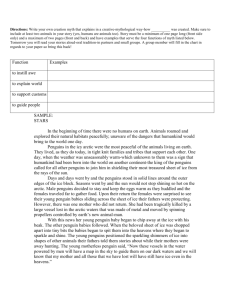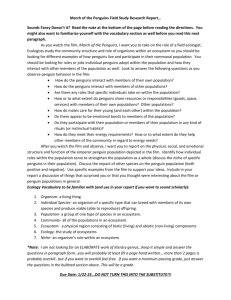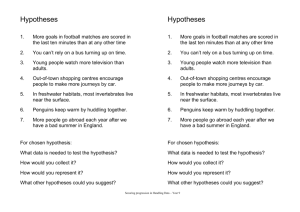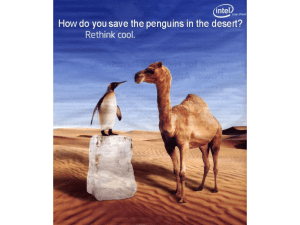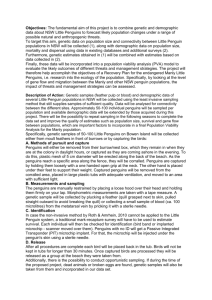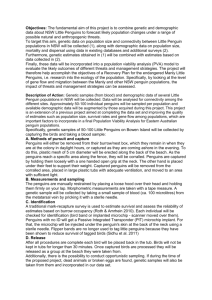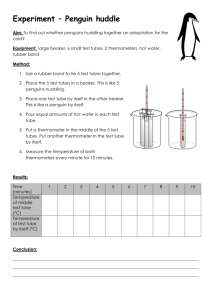APP as a word version
advertisement
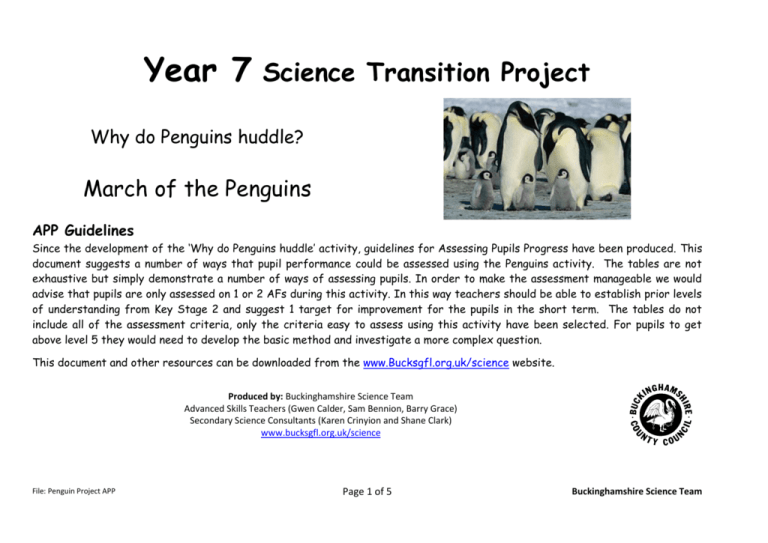
Year 7 Science Transition Project Why do Penguins huddle? March of the Penguins APP Guidelines Since the development of the ‘Why do Penguins huddle’ activity, guidelines for Assessing Pupils Progress have been produced. This document suggests a number of ways that pupil performance could be assessed using the Penguins activity. The tables are not exhaustive but simply demonstrate a number of ways of assessing pupils. In order to make the assessment manageable we would advise that pupils are only assessed on 1 or 2 AFs during this activity. In this way teachers should be able to establish prior levels of understanding from Key Stage 2 and suggest 1 target for improvement for the pupils in the short term. The tables do not include all of the assessment criteria, only the criteria easy to assess using this activity have been selected. For pupils to get above level 5 they would need to develop the basic method and investigate a more complex question. This document and other resources can be downloaded from the www.Bucksgfl.org.uk/science website. Produced by: Buckinghamshire Science Team Advanced Skills Teachers (Gwen Calder, Sam Bennion, Barry Grace) Secondary Science Consultants (Karen Crinyion and Shane Clark) www.bucksgfl.org.uk/science File: Penguin Project APP Page 1 of 5 Buckinghamshire Science Team AF1 – Thinking Scientifically Level 6 5 4 3 APP criteria Amplification: The pupil can: Identifies the strengths and weaknesses of particular models Identify strengths and weaknesses with the boiling tube model as a model of heat loss in lone and huddling penguins Explain processes or phenomena, suggest solutions to problems or answer questions by drawing on abstract ideas or models Explain the significance of huddling, using the results of the experiment and prior scientific knowledge of methods of heat loss, to illustrate how huddling reduces the rate of heat loss Describes how the experiment shows that huddling keeps penguins warm by comparing overall heat loss for the lone tube versus the huddling tubes Relate the single boiling tube to a lone penguin and the group of boiling tubes to a huddle of penguins Uses simple models to describe scientific ideas Represents things in the real world using simple physical models File: Penguin Project APP Page 2 of 5 Buckinghamshire Science Team AF3 – Communicating and collaborating in science Level 6 5 4 APP criteria Amplification: The pupil can: Choose forms to communicate qualitative or quantitative data appropriate to the data and the purpose of the communication Decide on the most appropriate formats to present sets of scientific data, such as using line graphs for continuous variables Produce a report on the investigation using the results table and line graph to illustrate the effects of huddling. The report should include a conclusion explaining how huddling reduces heat loss Draw a line graph showing heat loss over time for the lone penguin and huddling penguins Select appropriate ways of presenting scientific data Design results table to include units of measurement Use appropriate scientific forms of language to communicate scientific ideas, processes or phenomena Draw a simple bar chart illustrating total heat loss Use scientific and mathematical conventions when communicating information or ideas Present simple scientific data in more than one way, including tables and bar charts 3 Record the results of the experiment in a simple table, or by a picture or labelled diagram Use scientific forms of language when communicating simple scientific ideas, processes or phenomena File: Penguin Project APP Page 3 of 5 Buckinghamshire Science Team AF4 – Using investigative approaches Level APP criteria Amplification Apply scientific knowledge and understanding in the planning of investigations, identifying significant variables and recognising which are independent and which are dependent 6 Justify their choices of data collection method and proposed number of observations and measurements Collect data choosing appropriate ranges, numbers and values for measurements and observations 5 4 Repeat sets of observations or measurements where appropriate, selecting suitable ranges and intervals Select appropriate equipment or information sources to address specific questions or ideas under investigation Make sets of observations or measurements, identifying the ranges and intervals used Identify one or more control variables in investigations from those provided 3 Select equipment or information sources from those provided to address a question or idea under investigation Make some accurate observations or whole number measurements relevant to questions or ideas under investigation File: Penguin Project APP Page 4 of 5 It is unlikely that pupils would be able to reach this level with the simple equipment provided. To get a level 6 pupils should be showing an awareness of the need to use more accurate equipment such as dataloggers and recognise the impact of human error when using a thermometer. For pupils to access level 6, they would need to do a more complicated investigation such as how does the exposed surface area of the lone penguin affect heat loss compared to the exposed surface area of the huddling penguins. Record temperature at 30s or 60s intervals. Record a minimum of 5 results. Collect 3 sets of results and use these to calculate an average result. Plan to carry out the investigation using 1 boiling tube to investigate heat loss in lone penguin and a number of tubes grouped together to investigate heat loss in a huddle Record at least 5 results, measuring temperature of the water in the tubes at regular intervals Identify one way of ensuring this is a fair test: having the same size boiling tube, volume of water, time interval to record temperature etc With direction, use 1 boiling tube to investigate heat loss in lone penguin and a number of tubes grouped together to investigate heat loss in a huddle Measure total heat loss in lone penguin against huddling penguins Use a stop watch and thermometer accurately Buckinghamshire Science Team AF5 – Working critically with evidence Level 6 5 APP criteria Amplification Draw conclusions that are consistent with the evidence they have collected and explain them using scientific knowledge and understanding Explain the results of the experiment using scientific knowledge of methods of heat loss. Relate the results of the experiment to lone penguins and huddling penguins. Interpret data in a variety of formats, recognising obvious inconsistencies Explain the results of the experiment referring to the results table and / or line graph and relate to lone and huddling penguins Provide straightforward explanations for differences in repeated observations or measurements Identify any anomalous results and suggest explanations Draw valid conclusions that utilise more than one piece of supporting evidence, including numerical data and line graphs Evaluate the effectiveness of their working methods, making practical suggestions for improving them Identify patterns in data presented in various formats, including line graphs 4 Draw straightforward conclusions from data presented in various formats Identify scientific evidence they have used in drawing conclusions 3 Identify sources of error with the experiment and suggest ways of making the investigation more accurate and reliable Describe the results of the experiment as illustrated by a bar chart or simple line graph Describe one problem with the method and how the method could be improved Suggest improvements to their working methods, giving reasons Identify straightforward patterns in observations or in data presented in various formats, including tables, pie and bar charts Write a simple sentence describing the difference in total heat loss of lone penguin compared to the huddle of penguins Describe what they have found out in experiments or investigations, linking cause and effect Suggest 1 way of improving the experiment Suggest improvements to their working methods File: Penguin Project APP Page 5 of 5 Buckinghamshire Science Team

